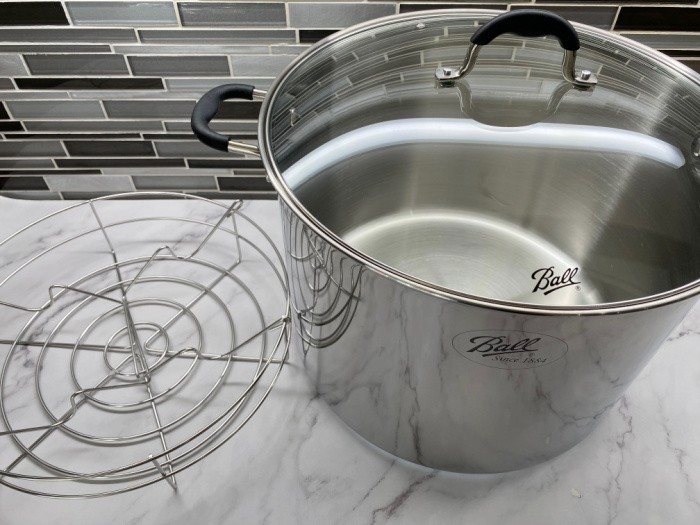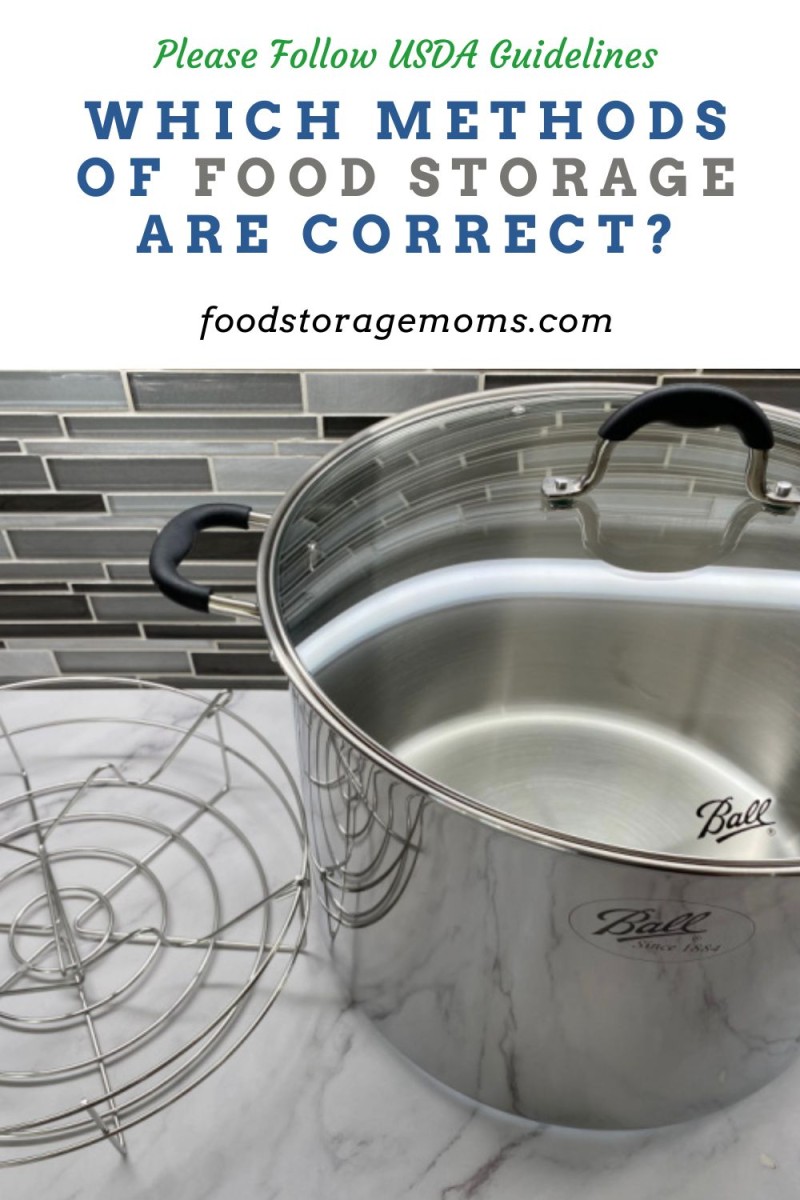Which Methods of Food Storage are Correct?

Food preservation is a process that is used to store food safely for a longer period of time. Not only does it help keep your food at its best quality, but it minimizes the possibility of bacteria growth, and also saves you a bunch of money in the long run by eliminating food waste. As many of you know, there are several food storage methods out there.
Which Methods of Food Storage are Correct?
I’d like to take a few moments to share with you not only what they are, but also the pros and cons of each of them. That way you’re able to decide for yourself which food storage method is best for you. This isn’t a comprehensive guide to food storage, but instead, an overview of which methods of food storage is correct. The main goal is to avoid food spoilage, so let’s check out these methods!

Canning
How many of you remember licking your chops while watching your grandmother or mother canning delicious jams and jellies, applesauce, and vegetables while you were growing up? Maybe some of you still continue with this practice today? Canning is a cost-effective food preservation method that has been practiced for centuries. Canned foods make for wonderful gifts, especially around Christmas time. Another benefit of this method is that you can get 1 to 5 years out of canned foods depending on what you’ve canned. Now, the USDA states one year, I get it. I admit I have eaten peaches that were 4 years old. They were still sealed and tasted great.
The basic steps for canning include sterilizing the jars and lids, preparing your food (washing, peeling, slicing) packing the food into the jars, sealing them with an airtight lid, and then heating them to a specific temperature for a specific amount of time in order to kill bacteria or any other microorganisms. You may also need to add acids like vinegar or lemon juice if they aren’t acidic enough.
Canning is especially beneficial for those living in rural areas because it can be done with produce from your own garden. However, it does have some drawbacks like the fact that you have to make sure the food is free from bacteria before canning. Canning also does allow certain foods to lose some of their nutritional value, but not entirely. The canning method is super popular still today!
- Pressure Canning 101: The Most Comprehensive Guide
- What is Water Bath Canning?
- Home Canning-Important Do’s and Don’ts
Dehydrating
Dehydrating is another type of food preservation that also dates back centuries ago. It can be used for things like fruits, vegetables, and even meats. Dehydrated foods don’t take up too much room because the water has been removed from them, making them great for long-term storage.
The process of dehydrating involves slicing your produce or meat into thin pieces in order to remove moisture quickly and evenly, then heating it up until all the moisture has been removed. Dehydrated foods are typically stored in airtight containers and make a convenient snack on the go.
The major benefit of this method is that you don’t have to worry about spoilage since there’s no liquid involved in the process. However, it does require the use of electricity which can be a bummer for those looking to minimize their energy consumption. Additionally, some of the food’s nutrients may also be lost while dehydrating them. Dehydrating food items is one of the most popular food preservation methods!
- 15 Foods You Should Be Dehydrating
- Dehydrating Onions and Make Onion Powder
- Dehydrating Kale and Make Kale Powder
- Dehydrating Tomatoes and Tomato Powder
Freezing
This method of food storage is probably one of the more common methods used today. We all know how convenient it is to pop something in the freezer for later use! As long as you keep your freezer at 0°F or less, frozen foods are safe to consume up to 6 months after they are prepared and stored properly. Freezing is especially beneficial for those living in urban areas because the majority of them don’t have backyard gardens.
The process of freezing food is simple. First, prep the food by washing, peeling, slicing, and then packing it into airtight freezer containers or bags. You’ll want to make sure to press out as much air as possible before sealing it and then placing it in the freezer.
Freezing is actually a great way to preserve foods while still keeping their vitamins and minerals intact as some of them are not lost during this method like they would with canning. The downside is that if your electricity goes out or you forget to put something back in the freezer after taking it out, you’d be wasting money on spoiled goods. In case of an emergency, you can shop in your own freezer, instead of going to the grocery store. Just make sure you have enough freezer storage space.
- How To Freeze Corn On The Cob
- How to Freeze Milk: Everything You Need to Know
- 15+ Items Perfect for Freezer Storage
Pickling
Pickling is a great alternative to canning and freezing, but more so for those who enjoy fermented foods. This method of food storage works best with vegetables like cucumbers, okra, onions, and carrots. Once you pickle these veggies in a jar filled with vinegar, sugar, water, and spices then seal them up tightly before refrigerating them; they will last several months!
The pros of this method are that there’s no need to use advanced equipment or heat food over high temperatures. Pickled foods keep their crunchy texture and have an extended shelf life due to the vinegar solution used which helps protect against bacteria. The cons are that this food storage method doesn’t preserve foods as long as other methods do (about 4-6 months) and that it doesn’t work with all vegetables. If you follow food safety guidelines, then pickling is easy!
Freeze-drying
When you hear the word freeze drying, you probably think of astronauts and their space food! But freeze-drying actually dates back to World War II when it was used by the United States Military. It is great for long-term storage because foods can be kept at room temperature in an airtight container or bag without losing any of their original flavor, texture, or nutritional value.
The freeze-drying process involves freezing a food item and then subjecting it to a vacuum chamber that removes any moisture from the food. This method happens to be very expensive so unless you plan on feeding an entire army; this may not be the best option for you. However, if money isn’t an issue then freeze-drying may be a great way to preserve and store food for an extended period of time. Proper food storage that stores food products long term includes the method of freeze-drying! When you ask “which methods of food storage are correct?” ..it would be freeze-drying!
Cold Storage
Cold storage is a great way to store fruits and vegetables for long periods of time. It basically involves keeping food in temperatures below 40°F, usually with extra humidity or carbon dioxide. This method works best with foods that don’t need oxygen like potatoes, apples, beets, carrots, and onions. You can store them at home by placing the product in an airtight container and then storing it in your refrigerator crisper drawer or even a root cellar if you have one available.
The pros of cold storage are that no electricity is involved and the food will remain fresh longer than if they were stored without this method. The cons are that not all types of food do well with this type of preservation so you’ll want to make sure to research what foods work and which ones don’t. Additionally, the items must be handled carefully in order to prevent it from rotting or becoming moldy. There are many different food types that you can do cold storage with, just make sure it’s one of the best methods for the food you’re wanting to preserve.
Final Word
So, which methods of food storage are correct? When it comes to long-term food storage, each method has its pros and cons depending on your individual needs and preferences. Canning is useful for those with large gardens and freezing works great for urban dwellers who don’t have much room to garden. If you like fermented vegetables then pickling could be a good option while freeze-drying is the best choice if money isn’t an issue. No matter which method you choose, make sure that you research how best to prepare, store, and consume your food before diving in! May God Bless this world, Linda
The post Which Methods of Food Storage are Correct? appeared first on Food Storage Moms.
